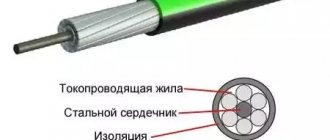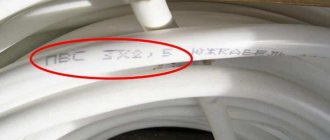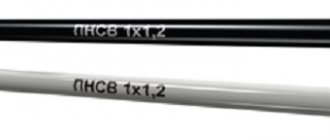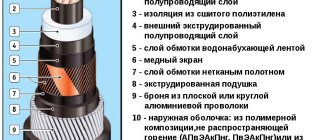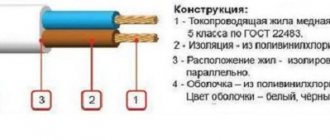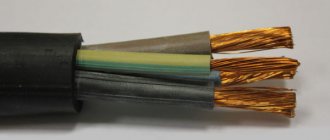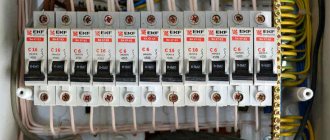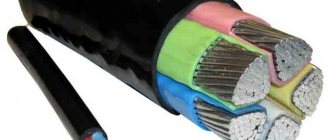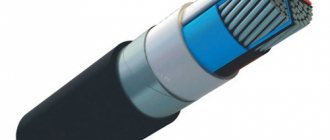The development of electrical networks and a significant increase in the number of consumers leads to numerous connections. Which is not possible to do with ordinary bare wires due to the danger of jamming and other factors. Therefore, the classic lines made with bare wire were replaced by SIP wire, which managed to occupy a niche for both household and industrial consumers. Such popularity of SIP was made possible due to a number of advantages in comparison with other brands.
Product marking
SIP cables are marked according to their type and cross-section, type of insulation, and technical properties. Manufacturers sometimes do not insulate the neutral core in some types of products: 1. SIP-1. The cable of this brand has 3 aluminum cores, for the insulation of which PET is used. This is the name of thermoplastic polyester - a synthetic film or fabric. The neutral core can be with or without insulation. If the letter “A” is present in the marking, the product is insulated. 2. SIP-2. This type of SIP cable has the same design as in the previous version with the difference that the neutral core is necessarily closed. This type of product is intended for installation on power lines whose voltage does not exceed 1000 V. Suitable for use in the northern regions of the country with a temperate climate. You can use a SIP cable for installation in summer cottages if the voltage does not exceed 380V.
3. SIP-3. This model differs significantly from previous product versions in its design - its core is made of steel and has an aluminum braid consisting of an alloy of silicon, magnesium, and aluminum. Single-core SIP wire is used when installing 20 kilovolt overhead lines. Manufacturers recommend using products of this type in areas with any climate, except sharply continental and arctic. According to the standards, this type of SIP wire can maintain its performance at temperatures from +90 to -20° C. 4. SIP-4. This type of product does not have a neutral wire. The design consists of several pairs of cores (two or four). If the marking contains the designation “H”, an alloy was used for their manufacture. If there is no letter designation, the cores are made of aluminum. Thermoplastic polyvinyl chloride is used for external insulation. 5. SIP-5. Products of this brand are similar in design to SIP-4 wires. The difference is the thermal insulation material - PET is used here. Thanks to this, the duration of exposure to permissible temperatures increases by 30%. SIP wires of this type are used for installation on 2.5 kilovolt power line supports. The installation of self-supporting insulated SIP-5 wires is allowed in areas with moderate and cold climates. What are the cross-sections of SIP cable? Phase conductors can have a cross-section with a diameter of 16 to 120 mm², and a zero-carrying conductor - from 25 to 95 mm².
Design and composition by type
There are 5 brands that differ in technical characteristics, composition and many other parameters. In addition, they have different purposes. The appearance is indicated by the number written immediately after the abbreviation.
SIP-1
A wire containing 4 cores, one of which is represented by a bare carrier neutral. It is produced according to European standards. LDPE insulation is used, which protects the product from exposure to ultraviolet radiation and moisture. It retains its properties even with prolonged heating up to +70°C and short-term heating up to +125°C.
What are the features
Next, you should consider the technical characteristics of sip wires, which have many advantages:
- Safety both during installation and during operation due to the high insulation of conductors;
- Resistant to negative environmental influences, from high humidity to ultraviolet rays;
- Ease of installation, since there is no need to erect load-bearing installations and apply an insulating layer;
- Long service life, ranging from thirty to fifty years.
However, there are also disadvantages:
- High cost of wire;
- The need to lay SIP at temperatures above -20°C;
- Inability to cool conductors;
- Low current limits.
The listed advantages make this wire the most popular and in demand.
Marking and decoding of SIP types
In accordance with the current standard GOST 31946-2012, SIP cables are distinguished into the following categories:
- with bare load-bearing core, products are designated SIP-1;
- with application of an insulator to the supporting conductor (SIP-2);
- power, with additional protective insulation (SIP-3);
- deprived of a supporting conductor (SIP-4).
All of the listed SIP wires can be supplied in a sealed version, which leads to the appearance of the letter G in the designation.
In accordance with the standard, two types of self-supporting cable products are distinguished:
- insulated type, designed for installation of overhead lines with voltage up to 1000 V;
- protected, serving for high-voltage lines 10-20 or 35 kV.
The standard also specifies the following parameters:
- number of main cores - from 1 to 4;
- the cross-sectional value of conductive elements is selected from the range - 16/25/35/50/70/95/120/150/185/240 mm2;
- cross-section of voltage-conducting elements in the absence of a supporting conductor - 16/25 mm2;
- neutral wire area - 25/35/50/54.6/70/95 mm2.
Several methods are used to mark wires:
- when using color marking of cores, it is applied to the outer surface in the form of stripes with a width of at least 1 mm;
- the neutral self-supporting wire usually has blue insulation of various shades (depending on the manufacturer);
- the insulation is marked with codes consisting of numbers and letters embossed on the surface of the material;
- the standard specifies the font size for markings, which should not be less than 5 mm in height and 2 mm in width;
- The code marking is repeated along the length of the cable every 500 mm, while no symbols are applied to the neutral core.
The manufacturer is required to mark SIP products with durable paint, which must retain its appearance under prolonged exposure to ultraviolet radiation. This simplifies the connection of new consumers to an existing line.
There are SIP cables that have core insulation with stripes of different colors:
- red;
- yellow;
- blue flowers.
In this case, the fourth wire does not have stripes. In this case, it is precisely this value that is zero.
An example of marking on the cable body SIP-2 3*35+1*50-0.6/1.0 TU 16-705.500-2006 is deciphered as follows:
- SIP-2 - wire type;
- 3*35 - number and cross-section in mm2 of main cores;
- 1*50 - number and area in mm2 of the zero or supporting core;
- -0.6/1.0 - permissible operating voltage (the dash sign is an indispensable part of the designation according to GOST);
- TU 16-705.500-2006 - compliance with the standard.
Many manufacturers produce wires with parameters different from those proposed by GOST, based on various technical conditions (TU) and internal standards. It is recommended to use cables manufactured in accordance with GOST 31946-2012.
Selecting a section and checking the product
When going to the store to purchase a self-supporting insulated wire, pay attention to the rated current. To calculate the required value, a diagram is formed that takes into account the length of the power network sections and the load on each of them.
After you calculate the approximate current value, compare it with the one indicated in the table below to select the SIP brand and cross-sectional size. Table of SIP cross-sections depending on permissible currents:
| Core cross-section, sq. mm | Permissible current for LPDE insulation | Permissible current for XLPE insulation |
| 16 | 70 | 100 |
| 25 | 95 | 130 |
| 35 | 115 | 160 |
| 50 | 140 | 195 |
| 70 | 180 | 240 |
| 95 | 220 | 290 |
| 120 | 250 | 340 |
For example, if the calculated current is 110 A, then you need to purchase SIP-1 with a cross-section of 35 square meters. mm or SIP-2 with a cross section of 25 sq. mm. The latter option is preferable, since such a wire will be lighter, stronger and more protected from wind and precipitation.
Advice! When choosing SIP, try to buy a wire with current-carrying conductors of a larger diameter than required according to the calculation. This will cover any load increases that occur in the future.
Before installing the wire, make sure that all wires are intact. To do this, use a multimeter:
- Switch the toggle switch to the “Test” position of the resistance sector, then connect the red and black probes to each other. If the device is working properly, you will hear a signal indicating that the dialing mode is activated.
- Using two probes, touch both ends of the SIP wire. If there is no damage to the conductor, you will hear a beep indicating that the charge has passed from one end to the other.
- These steps will need to be repeated for each core.
Similar checks should be carried out for a toggle switch installed in the resistance measurement sector from 200 Ohm to 200 kOhm. If the display shows “0”, then the conductor is intact, “1” - there is a break in the line.
Manufacturers
In Russia there are many factories that produce various cable products. The highest quality products are produced by large enterprises that meet all product quality requirements.
The most famous factories are:
- JSC "Moskabel Plant";
- JSC "Rybinskkabel";
- LLC GC "Sevkabel" and CJSC "Baltkabel" (St. Petersburg);
- Tomskkabel LLC;
- Kamsky Kabel LLC (Perm);
- CJSC Lyudinovokabel (Kaluga region).
When purchasing products from any manufacturer, it is recommended to check the availability of a certificate for the product and check that the cross-section of the cores corresponds to the declared parameters.
Peculiarities
SIP is a self-supporting insulated wire, used for power supply in power networks. The SIP electric cable is used in a network with voltage: SIP-1, SIP-2, SIP-4 and SIP-5 are designed for a rated voltage of up to 1 kV, SIP-3 up to 35 kV.
Most SIP wires produced in Russia are color-coded in accordance with the PUE (Electrical Installation Rules) and the new GOST 50462-2009. The insulation of phase conductors and the supporting neutral conductor is made of thermoplastic polyethylene or silanol-cross-linked (light-stabilized) polyethylene, which can withstand temperatures of about 80-90°C for a long time
The technical characteristics of the SIP cable are regulated by GOST R 52373-2005 / GOST 31946-2012 / TU 16-705.500-2006, according to which self-supporting insulated wires include products for overhead lines with voltages up to 0.6/1 kV inclusive, and protected wires, products for the same lines, but with voltage up to 10 kV; from 10 to 20 kV; 20 kV and 35 kV. There are different types of SIP wire. Most often, SIP type cables are classified by cross-section: 4x16, 2x16, 4x50, 4x25, 4x35, etc. Also, the brand of wire is divided according to the type of core insulation and technical characteristics:
- SIPT-1, also known as SIP-1 - except for the zero core, all the rest are insulated with special polyethylene. SIP-1 is produced for 380 V networks. This is a four-wire cable made of aluminum or aluminum alloy, three cores are covered with light-resistant polyethylene, resistant to ultraviolet radiation, and the fourth without braid with a steel core acts as a carrier and neutral.
- SIPT-2 and SIPT-1A - all threads are isolated;
- SIP-2 - all cores (except for the zero wire) are insulated with cross-linked polyethylene;
- SIP-2A - all conductors, including neutral, are covered with a layer of cross-linked polyethylene;
- SIP-3 - a wire consisting of one conductive core, made of a dense alloy or steel-aluminum wire structure, the insulating layer is made of cross-linked light-stabilized polyethylene. SIP-3 is used for transmitting electrical energy with voltages up to 20 kV;
- SIP-4 - all four cores are insulated with thermoplastic polyethylene, but there is no separate load-bearing core. When laying and tensioning the line, all conductors carry the load, i.e. fastening is carried out immediately for all conductors;
- SIP-5 - does not have a separate load-bearing core, the rest are covered with a sheath of cross-linked (light-stabilized) polyethylene, the number of cores is two or more. They are used mainly in enterprises or for extending electrical networks in the city or between populated areas. It consists of insulated strands coated with polyethylene, where each strand is wrapped in a separate sheath. Types of wire SIP-4 and SIP-5 do not have a supporting zero core and can consist of two or more threads (most often 2 or 3).
Why you can’t bring SIP into your home
First, the official information. According to GOST 31946-2012, according to which all SIP wire is produced in our country, “3.1 self-supporting insulated wire:
Stranded wire for
overhead power lines (...)”.
The exception, as I said, is only for the wire with the letter “n” - it can be laid along the walls of buildings from the outside. And even then – at a certain distance from the surface. The additional letter “n” in the marking indicates the fireproof design of the SIP. The polyethylene insulation of such wires is self-extinguishing and does not support combustion. However, such a wire cannot be brought into the house either.
A special feature of SIP insulation is that its insulation is designed for outdoor use. This means that it is resistant to sunlight. Cable insulation for indoor wiring must have a very low flammability, and resistance to sunlight is not important here.
Since SIP insulation is made of polyethylene, which burns with the formation of burning molten drops that set fire to everything around, the limitations on the scope of SIP use are understandable.
Some readers may have a question: why does it have to light up? After all, no one will deliberately set it on fire in the house. Here we remember the beginning of the article. Where it was said that a fire can occur at any time due to improper connection.
The main cores of SIP are made of aluminum or its alloys. As you know, aluminum is a soft metal and the contact connection tends to weaken over time. If the contact is not tightened in time, it will heat up. When heated, the contact resistance will increase, which will lead to even greater heating and cause arcing of the contacts. The problem grows like an avalanche: more heating - worse contact - more heating, etc. Aluminum “flows” inside the terminal and its tightening becomes weak.
The situation is complicated by the fact that the aluminum wire and the terminal material of the machine or meter (copper-brass alloy) have different temperature expansion coefficients.
This means that a situation may arise when the contact deteriorates and heats up so much that the SIP insulation begins to melt or catch fire. As an example, I will give a few photographs. Three-phase input to a circuit breaker in an electrical panel:
The result of incorrect connection of the SIP to the terminals of the circuit breaker. The counter also got it.
As you can see in the photo, due to poor contact and probably considerable load, the wire got hot, which led to the melting of the insulation, which began to flow down the body.
SIP insulation melted due to heating and flowed down
In the event of a fire, such insulation, continuing to flow, could possibly set fire to the entire panel. The photo clearly shows that the insulation was severely melted, and the owner decided to “fix” it with electrical tape.
SIP wires - the insulation melted due to heating
That is, the problem did not arise suddenly, they tried to eliminate it.
It is not the effect that needs to be eliminated, but the cause. And the reason here is an incorrect connection. One might say that the technology has not been followed. But more on that below.
When heated, a short circuit occurred and two wires burned out. One core remained intact (phase on pole 2). And two wires are soldered together and at the place of soldering you can see a burnt-out insulation (hole). There was little time left before the short circuit. The worst thing about this situation is that in the event of a fire, turning off the power supply would be problematic.
The same electrical panel in which the input circuit breaker was promptly replaced:
Reconnection of SIP and installation of a new input machine
Moreover, the ends of the SIP are again connected in the same way. This means the problem may repeat itself. Plus - it should be noted that the rating of the installed input circuit breaker is lower (it was 63 - now 40 A), which means that the maximum current of the SIP will be lower. But the question is: how long will it last? – remains relevant.
While we're on the subject, a couple more mistakes in this closet. After the introductory machine there is a nominal value of 63 A. It is unlikely that choosing such a large nominal value is advisable and safe. By the way, phase burnout is not as scary as zero burnout. If there is poor contact at the points 4th pole of the machine - 4th pair of meter contacts - bus N, not only a fire is possible, but also damage to single-phase household appliances. If you do not agree with me, read the articles What is a zero break in a three-phase and single-phase network and Three-phase electrical panel diagram - I answer the reader’s questions. I also described how to connect a PEN wire to the metering panel in the article Electrician in the mountains of Georgia. Well, there is no grounding, from the word “at all”.
Moreover, keeping in mind the possibility of SIP fire, it cannot be installed on flammable surfaces, even outdoors. Here is a photo sent by a reader. Here the “street” is the wall of a wooden country house:
SIP is turned on automatically on the external wall of a wooden house
The outgoing cable is not yet connected. I advised the reader to place a metal or asbestos substrate under the box, and take care of the quality of connecting the SIP to the terminals of the machine, which will be discussed below.
How is it deciphered?
First of all, it should be noted that the decoding of the SIP markings is as follows:
- C - self-supporting;
- I - isolated;
- P - wire.
Please note that, according to the abbreviation, this is still a wire, and not a cable, as many people believe it to be. I would also like to note that the prefix “A” at the end of the marking (for example, SIP-1A) indicates that the neutral core is covered with insulation
The prefix “n”, in turn, means that the current-carrying conductors are made of aluminum alloy, and the letter “t” at the end of the mark indicates that the insulation is resistant to elevated temperatures of +90°C (short-term +120°C)
I would also like to note that the prefix “A” at the end of the marking (for example, SIP-1A) indicates that the neutral conductor is covered with insulation. The prefix “n”, in turn, means that the current-carrying conductors are made of aluminum alloy, and the letter “t” at the end of the mark indicates that the insulation is resistant to elevated temperatures of +90°C (short-term +120°C).
SIP cable structure
Structurally, the SIP wire consists of individual aluminum conductors covered with an insulating layer on top, which is reflected in the designation diagram. For the manufacture of the protective shell, light-stabilized polyethylene with improved strength characteristics is used. The structure of the material does not change its parameters under the influence of ultraviolet radiation, which increases the service life of the wire.
As part of a cable with a cross-section of the main conductors of more than 50 mm2, auxiliary conductors (from one to three) for the following purposes can be used:
- For connecting lighting circuits. The cross-section is selected from three possible options - 16/25/35 mm2.
- For operation of control devices. Three versions of this wire are allowed - 1.5/2.5/4 mm2.
In a number of publications there are references to SIP-6 cables, supposedly slightly different from other products. Such products are not specified in the standard; this designation is erroneous. There is no mention in the standard and cable SIP-7, which, nevertheless, is produced by a number of enterprises (for example, Sevkabel). The wire has improved insulation and provides transmission of electric current with voltages up to 110 kV.
Cable design SIP-7
Brand SIP-5
The cable model SIP-5 differs slightly from the previous version. Visually, the wires are practically indistinguishable even to a specialist. Some changes have been made to the design to extend the service life of the product at critical temperatures. A number of enterprises produce wiring with non-combustible insulation suitable for installation inside a building. Such cables are designated with the prefix NG.
The table shows the characteristics of some SIP-5 wires.
| Characteristic | 2*16 | 4*25 | 4*70 | 4*120 |
| Permissible load, A | 105 | 130 | 240 | 340 |
| Short circuit current for 1 second, kA | 1,5 | 2,3 | 6,9 | 11,2 |
| Resistance of a 1 km long conductor (with the passage of direct current), Ohm | 1,91 | 1,20 | 0,443 | 0,253 |
| Core diameter, mm | 4,8 | 6,0 | 9,8 | 13,0 |
| External diameter of wire, mm | 16,8 | 23,4 | 34,6 | 43,6 |
| Approximate weight of 1 km of wire, kg | 138,1 | 400,5 | 983,1 | 1624,4 |
| Force required for breaking, kN (not less) | 5,0 | 15,4 | 43,0 | 73,7 |
| Thickness of the insulating layer, mm | 1,2 | 1,2 | 1,6 | 1,7 |
SIP-5 cable design
The design contains several wires made of aluminum alloy. There is no separate steel guide; its role is played by the cable cores themselves. The product is supplied in a wide range, differing in the diameter of the conductors. It is possible to use single-phase and three-phase current in networks (the number of cores in the wire changes accordingly).
Internal structure of SIP-5 cable
Features of the SIP-5 cable
The design feature is only the external insulation, made of cross-linked polyethylene. The use of such material made it possible to expand the time range of exposure to critical temperatures by a third.
The material used has the following advantages:
- the ability to preserve characteristics when heated to a temperature of 90-130ºС for up to 8 hours;
- short-term performance when overheated up to 250ºС;
- the surface remains elastic at low ambient temperatures;
- restoration of the original configuration after bending or overheating.
Scope of application of SIP-5 cable
The insulated cable SIP-5 is used to transmit electric current with a voltage of up to 1000 volts. Due to the wide temperature range of operation, the product is used for making connections to buildings, as well as for street lighting lines. Manufacturers recommend using the cable in regions with temperate and cold climates. The NG wire version is used for wiring inside residential and industrial premises.
Areas of use
The materials from which it is made, the design features, and therefore the scope of application depend on the brand of the product. In particular:
- SIP 1 wire is most often used in the construction of power lines and inputs into buildings;
- SIP 2 cables are also used for laying power lines and power supply to buildings. Their key feature is the type of atmospheric design, which allows them to be installed in places with high humidity, for example, on the shores of seas, lakes, in areas with poor environmental conditions and harsh climatic conditions, since their insulation is resistant to aggressive environmental influences;
- Products with the SIP 3 brand are used for laying sections of power lines with voltages from 10 to 35 kV. In addition, such a wire is used to connect equipment operating under high voltage. This is due to the cable design, which is able to withstand high-level loads;
- SIP 4 wires are used primarily for arranging various branches, since they have a higher level of flexibility. They are also distinguished by their frost resistance, which allows them to be used when laying power lines in the Far North;
- SIP 5 cable is used almost exclusively for installing branches.
Using SIP brand products
So, a SIP cable, which means that it is self-supporting (it has both phase and neutral wires) and insulated, is intended for laying power supply lines and branches from it. The operating voltage under which this product can be operated ranges from 0.4 to 1 kV, but for some brands it can reach 35 kV. The main advantages of the described products are ease of maintenance and low weight, which can significantly reduce costs when laying power lines. At the same time, it meets all requirements regarding the safety and stability of energy supply.
Reproduction and lifespan
The bird loves constancy; it nests in high places, on mountain slopes, between cracks in rocks. The bird settles in colonies (up to 20 pairs). Mating of a male and female occurs between January and March.
The female lays one white egg, but both the male and the female, alternating with each other, incubate the egg for 50 days and feed the chick for 130 days after hatching.
Griffon vulture chicks have their first downy plumage as a white color, after molting, the change in plumage becomes longer down and either a creamy shade or grey. By the fourth year of life, young males and females are sexually mature, but they begin nesting later.
Males in search of females to create their families begin to prepare from the beginning of January. Their preparation consists of repairing old nests or building new ones. Moreover, each nest is woven from twigs and stems of grass and strong sticks.
Birds build their nests in places inaccessible to humans and other animals, for example, in a rock crevice, but cattle must graze nearby. The nests have a height from 200 to 750 mm, a diameter from 100 to 3000 cm.
Most often, only one calf is born to a griffon vulture.
During the mating season, the male begins to attract the female while flying, he performs unusual tricks. On the ground, in order to attract the female to mating, the male demonstrates his stately profile and full face, spreading his wings and fluffing his tail, showing the beauty of his plumage, while creating crooning songs. This whole process takes place in the male in a bent state.
Egg sizes can range from 8 - 10 cm x 6.5 - 7.8 cm. The male and female replace themselves while laying the eggs to search for food. Parents feed their baby food that they regurgitate from their mouths. What food is complete for a baby due to its softness?
Small SIP, learns to fly from 3 or 4 months. He begins to master the technique of flight only at the age of one; his parents protect him. When the baby begins to fly, the whole family can fly from one place to another, but during the mating season it can return to its original place.
Installation. Video
Tips for installing SIP wires to your home are presented in this video.
It can be concluded that SIP cables have a number of advantages over older models of aluminum cables that do not have insulation. The cable is reliably protected from short circuits when laid in tree branches and other difficult operating conditions. It can be laid on the walls of buildings, structures, along fences, and does not require highly qualified workers. The absence of special supports and insulators reduces installation time and costs. Thanks to insulation and other design features, the scope of application of SIP cables has expanded significantly.
Laying conditions
Due to the fact that laying SIP does not require any special skills, it can be done either at home or by the enterprise’s own resources without the involvement of a specialized organization. Laying can be carried out both on supports and on structural elements of buildings and structures. As a rule, fastening to walls is much easier than on a free-standing support.
Therefore, consider the conditions for installing SIP wire on reinforced concrete supports:
- Since the self-supporting insulating wire has an insulated sheath, it is important to provide a suspension that prevents damage to the dielectric layer. To do this, plastic rollers, grips and thimbles are installed, along which the wire can move freely.
- During the installation process, it is forbidden to drag the SIP along the ground or tree branches, as these can damage its insulation.
- To join different sections of SIP, sealed piercing-type clamps are used. Thanks to this design, it is possible to tap a line from an existing one even under voltage.
- Before fixing it on the support, the SIP wire must be pulled out through the moving element (for SIP brands from 1 to 3 using a dynamometer until the normalized load is set). After stretching, it is fixed at the fixation points.
All fasteners are factory-made, so they can be found complete with self-supporting insulating wire, which will greatly simplify the task.
Rice. 6: Example of fastening a SIP wire to a support
Brand SIP-4
One of the modifications of a self-supporting wire, devoid of an additional power element. The product is supplied in coils (in the case of a cross-section up to 25 mm2), weighing up to 25 kg. If the specified values are exceeded, winding on drums is applied. Short cables (up to 100 m) can be untwisted manually; in other cases, a winch and rollers are used.
SIP-4 cable design
The cable consists of stranded aluminum conductors for primary and secondary purposes. On the outside there is a coating of light-stabilized polyethylene (cross-linked), having a thickness of 1.3-1.9 mm (depending on the cross-section of the cores). The veins are twisted together in the right direction, and with a large cross-section - in the left direction. An example of a cable is the products SIP-4 2*50 or SIP-4 4*120.
Various cable options SIP-4 (for single-phase and three-phase connection)
Features of the SIP-4 cable
A design feature of SIP-4 is the absence of a power core. Because of this, the strength of the product is reduced; it is used for arranging short highways. For example, to make a connection to a private building or between rooms. The interlacing pattern of the cable cores provides improved self-cleaning from adhering snow and ice.
Scope of application of SIP-4 cable
The wire is used for arranging overhead power transmission lines, as well as for forming branches. The cable is connected to residential buildings or outbuildings. The product can be used in lighting networks operating under voltages up to 1000 V (at a frequency of 50 Hz).
Scope of application of cables SIP-4 2x16 and 4x16
This type of wiring has the lowest cost among SIP-4, which makes it popular for connecting country houses and dachas. The wiring characteristics allow the transmission of electric current with a force of up to 16A, which is quite enough for a living space.
Scope of application of SIP wires 2x16 and 4x16
In everyday life, the most popular cables are 2x16 and 4x16. Thus, 4x16 wire is used for 0.6/1 kV overhead lines and for overhead branches to the building input. 4x16 cable can be laid along the walls of buildings and other structures.
SIP cable 2x16 is used to reduce the cross-section on branches during the transition from power lines to the internal wiring of the room. As a branch, 2x16 SIP is well suited for a summer house or country house.
Despite all the insulation, SIP is light in weight, which is convenient for installation. You can calculate the weight of a specific brand using tables. For example, the weight of SIP-4 with two cores:
The use of insulated wires instead of bare ones allows you to avoid short circuits and injuries due to current when the line breaks. At home, a cable can be laid by a person even with little qualifications.
Wire installation
The technology for installing SIP wires does not present any particular difficulties. Thanks to this, with the proper skill and free time, you can complete all the work yourself. But in order to install the SIP cable yourself, you must first coordinate the work with government services. In addition, before you begin installing the SIP wire to the house, you need to obtain permission from the company supplying electricity. In order to correctly carry out all the work on connecting the line, you need to carefully study the recommendations of specialists. The step-by-step instructions for installing SIP wires say: 1. First of all, you need to select a product of the required cross-section. Most often, for installing SIP cables from a pole to a house, products with a cross-section of 15 mm are used. 2. If the extension line exceeds 25 m, you will need to install additional support and use a tensioner.
3. In the case when it is necessary to branch the SIP cable line, additional components will be needed for installation - a special clamp. With its help, you can make punctures on the pole in the right places. The advantages of using clamps include simplified installation - you will not need to strip the cable. Next, installation of the SIP cable from the pole to the building is carried out according to the following plan: 1. Attach special fasteners to the support. Fasteners are necessary to ensure a strong connection. 2. Install the clamp. To do this, among the components for installing SIP wires there must be an anchor-type clamping device. It is a fitting with a bracket. 3. If wood was used for the construction of the building, according to the rules for installing SIP cables, additional insulation of the wire must be performed. To carry out wiring to stone or brick houses, there is no need to additionally insulate the wire. 4. Lead the wire 1 m into the building. 5. Make a branch inside the house. To correctly install SIP wires inside a building, you can watch a video. If necessary, a special coupling may be required to connect the cables.
How to install a self-supporting insulated wire
To install this type of cable and wire products, it is first necessary to secure the hooks to the overhead line supports. It looks like this:
These hooks are secured using bandage tape and yokes. The bandage tape is secured to the support using a special device for installing SIP, which is also shown in the top photo.
After the hooks are attached, special rollers are attached to them. The result should be the following construction:
Next, you need to connect the leader cable to the SIP wire and pass the cable through the rollers.
After the cable is pulled, you can stretch the SIP cable. This is usually done using a winch as shown in the top photo.
Important! If the distance between the supports is large, then it is recommended to install 2 anchor clamps for SIP on each support. Also, 2 anchor clamps must be installed when turning lines in order to evenly distribute the load on the supports.
In cases where the SIP wire consists of several sections, then their connection is made using special sleeves for pressing:
Advantages
In comparison with the old version of power transmission lines, self-supporting insulation insulation has a number of undeniable advantages:
- The reliability of continuous insulation allows you to avoid short circuits between phases with subsequent circuit breakage.
- Possibility of using smaller supports. Instead of standard 110s and 95s vibrating racks, you can install 85s or use supports made of wood.
- Reducing the standard distances from wires to buildings and structures, which increases the number of energy supply options in densely built environments.
- High level of safety for both power grid workers and electricity consumers.
- Reduced electricity losses due to the technical characteristics of SIP. The peculiarity of the wires is their low inductive reactance compared to analogues. For example, with a cross section of 70 mm2, the resistance of the SIP is four times less.
- Reduced fire hazard.
- Ease of maintenance. If you have the proper set of tools, technical work is carried out without turning off the power.
- Possibility of operation without clear cutting of trees. The dimensions of the clearing can be reduced even when a new line is laid.
- Long-term operation of the line subject to operating rules (30 years or more).
- Easy installation of wires on the facade of the building.
- Reduced costs for line arrangement. There is no need for additional elements in the form of insulators, hooks, traverses and clamps for them.
Advantages and disadvantages
The advantages of the products include the following characteristics: 1. There is no need to install powerful insulators on the line. 2. Security. Thanks to the insulation, there is no danger for specialists when servicing or installing self-supporting SIP wires. 3. Since the cores are connected by the same insulation, the width of the route is reduced. 4. Products can be used for regions with any weather conditions. 5. Eco-friendly. SIP cables do not affect people or animals. 6. Corrosion resistance. 7. Easy and simple installation of SIP wire. 8. Savings. To maintain and repair a line with exposed aluminum wires, you need to spend a lot of money, several times more than what is required for lines with SIP wires. Of course, there are also disadvantages, which include the large weight of wires of this type. Because of this, there is a need to more often install supports for installing the SIP cable to the house. If the products are used for installation in industrial enterprises, it will be necessary to perform reinforced insulation.
We mount it correctly
Once the appropriate cross-section of sip wires has been selected, you can proceed with the direct installation of the line.
The technique is no different from the usual organization of electrical wiring, but there are several fundamental differences:
Power cable brand ASB - characteristics, classification and rating of the best manufacturers. 115 photos and video instructions for choosingRetro wiring in a wooden house: calculation of parameters, design, installation and selection of vintage elements. 165 photos of stylish ideas
Heating cable for gutters and roofs: choosing and installing a self-regulating anti-icing heater with your own hands (135 photos + video instructions)
- Only special clamps and terminals should be used.
- Lines connect in the air, in flight.
- The wires must not be twisted or connected into bundles.
The price of self-supporting wires is justified by their stability, durability and optimal performance characteristics. Wiring installation will also be easy if you take into account all the tips given.
Types of wires
Today, four main SIP systems can be distinguished, and wire sizing tables can be easily found on the Internet:
Finnish, whose modern designation is SIP-1. Among the cores there is one non-isolated one, which takes on the role of a carrier. A variety of the specified brand SIP-1A, which has a significant distinctive feature. More on this a little further.
The second is called Torsada, the more common version in Russia is SIP-2. In this system, the supporting conductor is covered with an insulating layer. This is done to protect the zero core in areas where there is a polluted climate. Another name (outdated version) is SIP-2A.
The third involves a power line with a power rating of up to 35 kW (inclusive). The wires do not form a twisted bundle, each goes to its own phase. As the load increases, installation of SIP-3 is required.
The fourth has such a feature that all four conductors carry the load - it is distributed equally between the neutral and phase conductors, and all conductive conductors are covered with an insulating protective layer. The markings are different - SIP-4, SIPs-4, SIPt-4, etc.
If you look at the photo of the sip wires, it becomes clear that the specified conductor is insulated with thermoplastic polyethylene, which is considered a cheaper protective layer. The other two conductors are covered with cross-linked polyethylene, due to which they have improved heat resistance.
Lifestyle and habitat
If you look at it, you can see that the griffon vulture in the photo has a long tail, wide wings, a mature male and a female have a collar with long white down on their neck. Despite its size, the bird's head is small, and the plumage on its head is white.
Settling on the mountain peaks of the North Caucasus, the bird provides itself with food and ease of soaring in the air. The bird chooses mountainous and rocky habitats due to its size, as it is difficult for it to take off from flat surfaces.
The take-off mechanism of the wings has rare flaps, but at the same time deep, so it is easier for the bird to fly off rocks and cliffs without touching the surface with its wings, and on a flat surface this flapping of the wings makes it difficult to move quickly and take off. The bird makes terrifying croaking sounds when communicating with its relatives.
The arid habitat of their habitat increases the possibility of their survival, since the bird is a predator; it feeds and survives on carrion. The lifespan of adults is up to 25 years; in zoos they can live up to 40 years.
Cable designation
According to GOST, the marking of conductors should look like:
- The first symbols are “SIP”, indicating the type of conductor;
- The numbers from 1 to 4 are indicated with a hyphen;
- At intervals, numbers are added that indicate the number of each type of core, then through the multiplication sign - their cross-section. Numbers related to each type are separated from each other by a “+” sign;
- A dash indicates the rated voltage of the cable;
- Technical specifications may also be indicated at intervals.
For example, if the marking SIP-2 3×70 + 1×95 + 2×25 – 0.6/1 TU is indicated, then the parameters of the self-supporting insulated wire are as follows:
- designed for organizing overhead power lines;
- has veins:
- 3 main sections 70mm2;
- 1 insulated carrier with a cross-section of 95mm2;
- 2 auxiliary sections 25mm2.
- The cable is designed for voltage 0.6/1 kV.
Where is it used?
Most often used in the construction of overhead power lines, as well as for branching from it to buildings and private houses. Now organizations selling electricity are forcing new subscribers to use SIP. And all because it is problematic to illegally connect to such a conductor from the outside. That is, it is impossible to jump on them like you would on bare wires.
At the same time, good insulation reduces the risk of electric shock to operating personnel. And if previously it was strictly forbidden to carry out connection and maintenance work without de-energizing the line, then with the advent of SIP, all this can be done with voltage on it.
In addition, installing a self-supporting wire is much easier. You just need to secure the harness to the wall of the house or a support, having previously tensioned it using a winch or other special device. To do this, each brand of self-supporting wire has all the necessary mounting hardware. Although this also has a drawback: electricians need to know about all types of fittings plus have the skills to use them.
Technical characteristics of SIP 2 cable
SIP 2 wire is produced with the following technical characteristics:
- the number of conductors can be from 1 to 4;
- the cross section is in the range of 16-120 mm2;
- the zero core is made of aluminum alloy and has a steel core;
- rated voltage – 0.6-1 kV;
- insulation material – light-stabilized silanol cross-linked polyethylene;
- relative humidity of the operating environment – up to 98%;
- the minimum bending radius is 10D, where D is the diameter of the wire;
- installation of the wire is allowed at a temperature of at least -20°C;
Temperature parameters:
- Operating temperature range – -60°С – +50°С. Thanks to these properties, the cable can be used when laying electrical networks in a cold climate zone;
- Heating up to +90°C for 8 hours is allowed;
- Short-term heating up to 130°C is allowed;
- The permissible short circuit temperature is +250°C.
Attention! During operation, heating up to 90°C is possible. It is allowed to be allowed for no more than 8 hours per day, no more than 100 hours per year and no more than 1000 hours for the entire period of work.
The warranty period is at least 3 years, the service life must be at least 40 years.
Strength characteristics of SIP 2
| Nominal cross-section of zero and main cores, mm2 | Core tensile strength, kN, not less |
| 25 | 7,4 |
| 35 | 10,3 |
| 50 | 14,2 |
| 70 | 20,6 |
| 95 | 27,9 |
| 120 | 35,2 |
| 150 | 43,4 |
| 185 | 53,5 |
| 240 | 69,5 |
Depending on the number of cores and their cross-section, cables have different weights and diameters.
Characteristics of the diameter and weight of SIP 2 wire
| Number and cross-section of cores | Outer diameter of wire, mm | Weight of 1 km of wire, kg |
| 1x16 + 1x25 | 16,4 | 167 |
| 3x16 + 1x25 | 24,1 | 307 |
| 3x25 + 1x35 | 27,1 | 424 |
| 3x35 + 1x50 | 30,8 | 570 |
| 3x50 + 1x50 | 34,1 | 729 |
| 3x50 + 1x70 | 36,1 | 799 |
| 3x70 + 1x70 | 40,0 | 1010 |
| 3x70 + 1x95 | 41,8 | 1086 |
| 3x95 + 1x70 | 44,2 | 1247 |
| 3x95 + 1x95 | 45,9 | 1323 |
| 3x120 + 1x95 | 48,1 | 1545 |
| 3x150 + 1x95 | 50,9 | 1812 |
| 3x185 + 1x95 | 55,0 | 2162 |
| 3x240 + 1x95 | 59,6 | 2652 |
| 4x16 + 1x25 | 24,1 | 377 |
| 4x25 + 1x25 | 27,1 | 522 |
Ice formation on wires
The accumulation of wet snow and the formation of ice on wires is a completely typical situation in severe winter conditions. The question arises, which sip wires cope best with this problem? In general, it is worth paying tribute to all self-supporting wires, but the SIP-4 brand is insured against this phenomenon to the maximum.
When such an emergency does occur, the so-called automatic discarding of the resulting layers is carried out within a fairly short period of time. A similar effect becomes possible due to imbalance due to additional loads from snow and ice.
SIP is a relatively new generation of wires for conducting overhead power lines with high operating efficiency. One of the main advantages of this type of wire is the ease of installation and further operation.
But it is worth remembering that any manipulation associated with connecting wiring to the network should only be carried out by an experienced electrician.
Examples of connecting SIP to a house
Well, the whole connection process is shown in Dmitry’s video, Electrician’s Notes channel:
The conclusion of the article is simple. Long-term trouble-free operation is guaranteed only if the SIP is correctly connected. But such a connection is the most complex and responsible in the entire house, and requires careful preparation and high qualifications.
I ask readers to vote - which method of connecting SIP do you use?
Thank you all for your attention, I look forward to questions and criticism in the comments!

